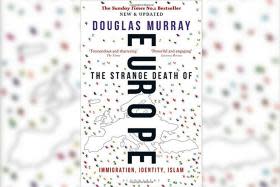New book puts the movement of people into deeper context

Like the proverbial man with the hammer for whom everything is a nail, for the liberal-minded professor of migration everything significant in post-war Europe has had the indomitable migrant at the heart of it. This book is a work of advocacy on behalf of the “voiceless” migrant and refugee, though because there is so much to cram in, it often reads like a list of events interspersed with bouts of indignation.
Its claim to originality lies in connecting what author Peter Gatrell calls the “violent peacetime” of late-Forties Europe, when as many as 17 million people were on the move, with the subsequent post-colonial migrations, the new wave of relocations after the collapse of the Soviet Union and the more recent refugee crisis.
This continuity serves a polemical purpose by implying that Europe has always been on the move, so why are we so irrationally unsettled about it now? But the analogy does not bear examination. The movement in the Forties was a one-off migration of Europeans, with more than 10 million of the 17 million on the move being the German minorities who had been scattered through eastern Europe and Russia, many of them settled there for hundreds of years, but who now had to return to Germany in a hurry, paying the price for Hitler’s war.
The more recent immigration story into Europe has been mainly from outside the Continent, from more culturally distant places, and it is ongoing. And in recent years the cumulative scale has been greater than in that post-war turbulence. Britain, for example, was relatively untouched by those post-war movements beyond absorbing a few hundred thousand displaced persons or people, mainly Poles, fleeing communism.
Read more
New book explains why we should make the most of our time on Earth
But in the past 20 years immigration has increased the population of the UK, mainly England, by more than five million. In 1970 the population of London was almost 90 per cent white British and it is now about 40 per cent.
Gatrell’s book reminds me of those arguments about immigration when the pro-immigration advocate, dismissive of current anxieties, will point to the fact that 50,000 Huguenots arrived in the 17th century as evidence that we have always been a melting pot. For the past 15 years more than 500,000 people have arrived every year, albeit many of them temporarily. Scale matters.
The one country for whom the analogy with the post-war period might work is Germany. After absorbing so many ethnic Germans into a shattered country just after the war, the country was faced with another huge wave of newcomers after 1989: yet more ethnic Germans from the former Soviet Union, a wave of several million east Germans moving west and hundreds of thousands of asylum seekers from the Balkan wars.

Gatrell is right to devote so much space to Germany and the book does have some other redeeming features: the story of how Poles from the land lost to the Soviet Union in the east were transferred to occupy the new lands taken from Germany in the west; the ambivalence shown to the returning white settlers after the end of empire in many places, especially France; his detailed knowledge of population movements in Russia and points east.
Yet he also fails to convince on the centrality of migration to most European countries, at least until the political disquiet of recent years. The creation of welfare states, the movement from country to town, mass affluence, gender equality, mass secondary and then higher education, de-industrialisation were all major developments in which migration played a negligible role.
Read more
The Strange Death of Europe by Douglas Murray - review
And the book essentially ignores native populations. When the natives are not racist they are patronising, even when teaching someone to use a fork, something that one might think would be quite helpful. Newcomers are hard-working, resilient, cheerful, and have come selflessly to rebuild economies, serve in the NHS, and so on.
He is right that British politicians over-claim for the UK’s generosity on asylum, especially in recent years, but fails to mention the one period when we were absorbing about 100,000 a year for a few years at the time of the Kosovo conflict. And the hostile environment was not, as he says, for migrants but for illegal migrants — rather an important difference.
This is not a book for trade-offs or dilemmas and Gatrell is too incurious to consider how a desirable degree of migration openness can be reconciled both with most peoples’ preference for a relatively stable way of life and with the tenacity of attachment to nation states and citizenship, which is surely the real lesson of the post-war European story.
The Unsettling of Europe: The Great Migration, 1945 to the Present by Peter Gatrell (Allen Lane, £30), buy it here.
Read more
Read more New book explains why we should make the most of our time on Earth

 Yahoo News
Yahoo News 


